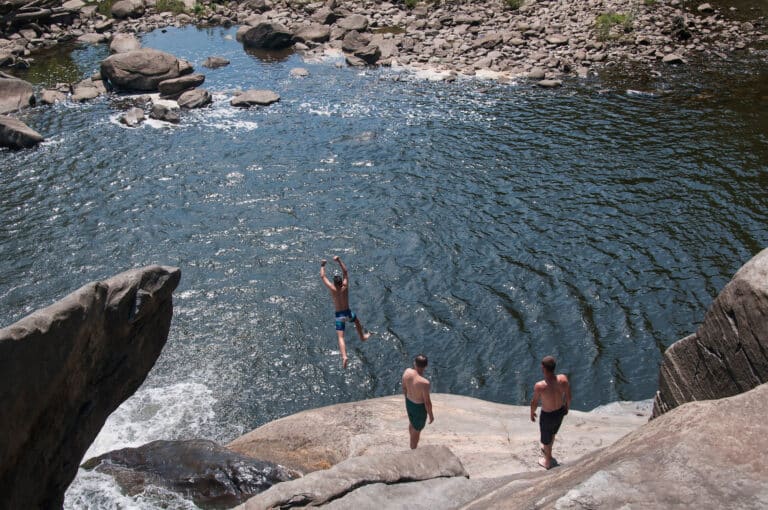YES
Chris McDougall’s bestseller Born to Run is about dealing with foot pain. It starts with the usual trips to the doctor, shoe stores, and orthotic makers. With more care, there was always more pain. So he chose a different route and journeyed to Mexico’s Copper Canyon, where Tarahumara Indians run hundreds of miles in flat rubber sandals—happily into their 80s.
Similar to McDougall, my voyage of discovery began with watching Kenyan runners’ barefoot movement. After years of injuries, I learned how to run softly, and with a new painless stride, I ran a 2:28 at the Marine Corps Marathon.
In 10 years since, my learning has deepened about how the foot interacts with the ground. Efficient runners land lightly on their mid-foot (not the heel), have a slight forward lean, and are completely relaxed and happy. To execute the technique, I’ve learned the best shoe is less shoe.
While competing for Brooks, a lead designer there had me cut a centimeter off the heel of a traditional running shoe. To him this was the perfect shoe—flat from toe to heel. Most running and walking shoes have almost an inch of heel elevation.
Although it felt a bit strange at first, after a week I felt perfectly aligned, and I could feel the greatly increased elastic recoil in my feet and Achilles.
 Every study performed in runners shouts at these principles, but culture and marketing have suppressed them. The arches of your foot and positions on bones and tendons have support and stability only when flat to the ground. Mess with the structure and it weakens.
Every study performed in runners shouts at these principles, but culture and marketing have suppressed them. The arches of your foot and positions on bones and tendons have support and stability only when flat to the ground. Mess with the structure and it weakens.
Walt Whitman wrote: “The press of my foot to the earth springs a hundred affections.” He too understood the magic of your feet feeling the ground. Paradoxically, with more pillow-type cushion, the less you feel the ground, and the more impact on your structure. Every upstream muscle wakes up when the 200,000 nerve endings in your feet can feel, adapt, and react. This is why gymnasts, acrobats, and dances never wear cushioned supportive shoes.
McDougall and I both agree that it is not really about the shoes—or lack thereof—but more about understanding how your body stands and moves, improving strength and function, and then figuring out what shoe to wear. This teaching is all about proper biomechanics, and if you need shoes, wear something that does not get in the way.
—Dr. Mark Cucuzzella, Associate Professor at the West Virginia University School of Medicine
NO
I don’t deny that minimalist shoes can help certain people, but to say they will help everyone is dead wrong. Running is a very individual thing, and you have to experiment and find out what works for each individual. I am putting this in the context of 40 years of distance running and 25 years of treating patients. As a sports podiatrist, I look at the type of injury, foot type, and training, and then recommend options that change bad patterns.
There’s not a single shred of evidence that barefoot runners get fewer injuries. In fact, many clinics are reporting that they’re now seeing different types of injuries in barefoot runners. We’re seeing a rash of metatarsal stress fractures in people running in Vibram FiveFingers. This is a shoe that’s supposed to be preventing injuries, but it’s causing them after only a few years on the market. Shoe companies are starting to make a lot of money, but we’re only beginning to see new injury patterns resulting from this trend.
The concept of wearing a lightweight shoe with minimal padding is nothing new. Back in the 70s—during my college running days—we intuitively realized we needed to rotate shoes depending on use. Today’s barefoot craze is just the pendulum swinging back away from thicker-soled shoes. It’s become a fad with a lot of hype, because people are looking for something unusual to improve their running. This is a marketing scheme that’s being embraced by a bunch of zealots, who have been convinced by reading Born to Run, which is full of mistruths.
The causes of running injuries go way beyond the type of shoe you are wearing. It could be training errors or improper technique. The average person is 50 pounds heavier than he or she used to be. Think about the impact that has on your feet. I am not saying thicker shoes don’t cause injuries, but intelligent people without bias will agree that different shoes cause different injuries. We have to look at all of the factors that could be causing injury and not believe we have somehow found a magic bullet in minimal shoes.
—Dr. Kevin A. Kirby, Associate Professor of Podiatric Medicine at Samuel Merritt University







